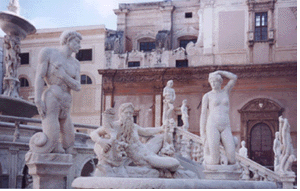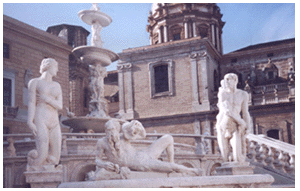...Best of Sicily presents... Best of Sicily Magazine. ... Dedicated to Sicilian art, culture, history, people, places and all things Sicilian. |
by Carlo Trabia | ||
Magazine Index Best of Sicily Arts & Culture Fashion Food & Wine History & Society About Us Travel Faqs Contact Map of Sicily |
The work was essentially completed between 1552 and 1555 by the Florentine sculptor Francesco Camilliani, assisted by Michelangelo Naccherino and, of course, several apprentices (a common practice). It was intended for the garden of Luigi de Toledo, brother-in-law of Cosimo de Medici and son of a viceroy of Naples. It seems that Luigi could not afford the fountain, or at least could't afford to maintain it, so he sold it to the Palermo Senate in 1573. Over the next few years Camilliani's son, Camillo, set it up in Palermo, adding some original localized details such as the occasional Sicilian goddess, and creating the enduring legend that its four lower pools represented the four rivers (actually streams) of Palermo --the Papireto, Maredolce, Oreto and Gabriele. The figures of white Carrara marble, now coated with an anti-mold and anti-pollution The fountain was viewed as a way to boost the prestige of a local governent which by the sixteenth century was a shadow of its former (royal) self. Viceroys, not kings, resided at Palermo, and the senate (actually a city council) wanted to convince people of its importance. This had mixed results, but the fountain immediately became an important cultural point of reference. The problem was that Palermitans either loved or hated the unique fountain flanked by the city hall, the monastic churches of Saint Catherine of Siena and Saint Joseph of the Theatines, and the palazzi of two local noble families. There seemed to be no impartial or "middle" ground. Sicily had been under Spanish control for many years. The influence of the Inquisition had left the island, and particularly Palermo, with some attitudes that were rather more conservative than those of the Florentines. The nude figures, with their unabashed sexuality, did not go unnoticed or uncriticized. The Palermitans sooned re-christened the square housing the fountain the "Piazza of Shame," a nickname that endured well into the twentieth century. The fountain has nearly fifty figures. All were restored for the monument's re-opening in January 2004. Located near the Quattro Canti, the Martorana church and other landmarks, it is well worth visiting. About the Author: Architect Carlo Trabia has written for various magazines and professional journals, as well as this online magazine. | |
Top of Page |
 Recently restored, the centrally-located Pretoria Fountain, next to Palermo's municipal building (city hall), is a point of focus in a city where artistic monuments are not lacking. Ironically, the Pretoria Fountain is not, strictly speaking, Palermitan or even Sicilian. Most of its major pieces were created for a Tuscan villa. Only when it was decided to bring the unique work to Palermo where certain figures traditionally associated with Sicily (such as the goddess Ceres) added to "complete" it.
Recently restored, the centrally-located Pretoria Fountain, next to Palermo's municipal building (city hall), is a point of focus in a city where artistic monuments are not lacking. Ironically, the Pretoria Fountain is not, strictly speaking, Palermitan or even Sicilian. Most of its major pieces were created for a Tuscan villa. Only when it was decided to bring the unique work to Palermo where certain figures traditionally associated with Sicily (such as the goddess Ceres) added to "complete" it. substance, are essentially mythological. Water spouts from the heads of beasts, and the more human figures are gods and goddesses. The style is typical Renaissance Florentine, to some extent reflecting the approaches of the individual sculptors who worked with Camilliani.
substance, are essentially mythological. Water spouts from the heads of beasts, and the more human figures are gods and goddesses. The style is typical Renaissance Florentine, to some extent reflecting the approaches of the individual sculptors who worked with Camilliani.